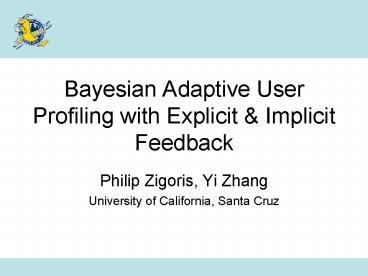Bayesian Adaptive User Profiling with Explicit PowerPoint PPT Presentation
1 / 30
Title: Bayesian Adaptive User Profiling with Explicit
1
Bayesian Adaptive User Profiling with Explicit
Implicit Feedback
- Philip Zigoris, Yi Zhang
- University of California, Santa Cruz
2
Obstacles to Personalization
- Asking for feedback is intrusive.
- Implicit Feedback - Infer user feedback from
user behavior. - Little to no information about new users (the
cold-start problem). - Borrow information from existing users via
Bayesian hierarchical model.
3
Outline
- Implicit Feedback
- Hierarchical Bayesian Framework
- Gaussian Network
- Experiments
4
Implicit Feedback
- A users interaction with a document suggests
their opinion of it. - Includes
- Keyboard usage
- Mouse usage
- Viewing time
- Eye-tracking
- Appeal cheap!
- Modulo security issues
- Question Does it have any predictive value?
5
Is Implicit Feedback Useful?
- Yes
- Positive correlation between the time spent
viewing a page and a users opinion of the page.
Claypool et al., 2001 Fox et al., 2005 - No (sometimes)
- ? In Kelly et al., 2004 demonstrates that
correlation varies significantly across tasks.
6
Outline
- Implicit Feedback
- Hierarchical Bayesian Framework
- Gaussian Network
- Experiments
7
The Task at Hand
Doc Rating
X1 Y1
f
X2 Y2
X3 Y3
I Like!
8
Cold-Start Problem
- Personalized systems require training data.
- Users do not want to endure poor performance
while the system is learning.
Solution Give the system a head-start with some
(Bayesian) prior knowledge.
9
Bayesian Prior over User Profiles
User-Model Space
10
Hierarchical User Model Generic Form
Parameter describing prior distribution
11
Refining Beliefs Based on User Data
12
The Posterior Distribution
Maximum A Posteriori model
Influence of prior
Data likelihood
13
Tradeoff Prior vs. Data
- More data data likelihood term will
dominate the objective function.
14
Outline
- Implicit Feedback
- Hierarchical Bayesian Framework
- Gaussian Network
- Experiments
15
Gaussian Network
16
Learning the Prior from Existing Users
Unbiased estimator for prior parameters
17
Outline
- Implicit Feedback
- Hierarchical Bayesian Framework
- Gaussian Network
- Experiments
18
Experimental Datasets
Claypool
- 75 Student Volunteers, 1823 Documents
- Unguided, unrestricted web browsing for 20-30
minutes - Every document explicitly rated (Scale 1 to 5)
Zhang
- 15 Users, 4663 Documents
- 1 month, users spent gt1 hour everyday using
system - Focused on reading news articles
- Not every document is explicitly rated (Scale 1
to 5) - Includes other forms of explicit feedback (TBA)
19
Feature Sets
20
Evaluation Methodology
- Tested four models
- Linear model with (P)rior
- Linear model with (N)o prior
- (G)eneric, user-independent model
- Moving (A)verage
- Original ordering preserved
- Leave-one-user-out
- Model updated and evaluated (error2) after every
example
21
Summary of Results
Implicit Explicit
Implicit
Explicit
Performance (MSE) averaged over time and user.
Hierarchical model significantly outperforms
other methods. (95 Wilcoxon signed rank
test)
22
Performance Over TimeExplicit Implicit Feedback
Shifting rating bias
Personalization seems to begin
Prior getting in the way
23
Performance Over TimeImplicit Feedback Only
(Zhang et al)
Follows moving average
Implicit feedback becomes useful
24
Performance Over TimeImplicit Feedback Only
(Claypool et al)
25
Comparative Performance with Different Feature
Sets
Implicit feedback hurts performance
Implicit feedback benefits performance
26
Discussion The Dynamics of the User Model
27
Discussion Is Implicit Feedback Useful? Why?
- Error can be decomposed into
- Bias - How closely the learning algorithm can
approximate the best solution. - Variance - Sensitivity of learning algorithm to
the training sample. - Noise - Irreducible uncertainty of problem
- Including implicit feedback increases variance.
This explains why - Negative impact on early performance
- Requires substantial amount of training data to
be useful. - Linear model has strong bias. This may explain
why - Implicit feedback does not perform well on its
own.
28
Discussion Shifting User Behavior
- Implicit assumption of our model
- User behavior is consistent over time.
- Already observed shifting bias in rating.
- Also, observed shifts in keyboard and mouse usage.
29
Conclusion
- Implicit feedback (of the type used in our study)
has marginal predictive value. - A question of when, not if
- Requires personalization
- Requires lots of data
- Hierarchical model effectively alleviates
cold-start problem - Shifting user behavior exists
30
Thank You!

